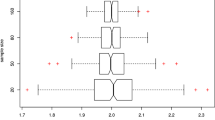Abstract
A technique for deriving and interpreting fractal geophysical processes with power-law spectra of a different nature is described. Examples include the energy spectra of atmospheric processes and their role in the mixing of impurities, the frequency spectra of sea wind waves, and the spatial spectra of the surface relief of celestial bodies in the solar system. A.N. Kolmogorov’s works in the early 1930s, which were subsequently developed by his followers A.M. Obukhov, A.S. Monin, A.M. Yaglom, and others, are the most important for this. Kolmogorov’s probabilistic laws serve as a model for the analysis of the processes under consideration by methods of the similarity and dimensionality theory.



Similar content being viewed by others
REFERENCES
A. N. Kolmogorov, “Zufällige Bewegungen,” Ann. Math. 35, 116–117 (1934).
A. S. Monin and A. M. Yaglom, Statistical Hydromechanics, Vol. 2 (Nauka, Moscow, 1965; MIT Press, Cambridge, MA, 1975).
A. M. Obukhov, “Description of turbulence in terms of Lagrangian variables,” Adv. Geophys. 6, 117–119 (1959).
G. S. Golitsyn, “Laws of random walks derived by A.N. Kolmogorov in 1934,” Russ. Meteorol. Hydrol. 43, 135–142 (2018).
G. I. Barenblatt, Scaling (Cambridge Univ. Press, Cambridge, 2003).
G. I. Barenblatt, Self-Similarity Phenomena: Analysis of Dimensions and Scaling (Intellekt, Dolgoprudnyi, 2009) [in Russian].
G. I. Barenblatt and Ya. B. Zel’dovich, “Intermediate asymptotics in mathematical physics,” Russ. Math. Surveys 26, 45–61 (1971).
A. M. Obukhov, “Local structure of atmospheric turbulence,” Dokl. Akad. Nauk SSSR 67 (4), 643–646 (1949).
G. S. Golitsyn, Statistics and Dynamics of Natural Processes and Events (Krasand, Moscow, 2013) [in Russian].
G. D. Nastrom and K. S. Gage, “A climatology of atmospheric wave-number spectra of wind and temperature observed by commercial aircraft,” J. Atmos. Sci. 42 (4), 950–960 (1984).
E. Lindborg, “Can the atmospheric kinetic energy spectrum be explained by two-dimensional turbulence?” J. Mech. 388, 259–288 (1999).
G. K. Batchelor, “Computation of the energy spectrum in homogeneous two-dimensional turbulence,” Phys. Fluids 12 (Suppl. 2), 233–239 (1969).
R. H. Kraichnan, “Inertial ranges in two-dimensional turbulence,” Phys. Fluids 10 (7), 1417–1423 (1967).
H. Kelley and W. I. Goldberg, “Two-dimensional turbulence: a review of some recent experiments,” Rep. Prog. Phys. 65, 845–894 (2002).
J. Charney, “Geostrophic turbulence,” J. Atmos. Sci. 29 (6), 1087–1095 (1971).
R. H. Kraichnan, “Inertial-range transfer in two- and three-dimensional turbulence,” J. Fluid Mech. 47 (3), 525–536 (1971).
J. N. Koshyk and R. Hamilton, “The horizontal kinetic energy spectrum and spectral budget simulated by a troposphere-stratosphere-mesosphere GCM,” J. Atmos. Sci. 58 (4), 329–348 (2001).
G. I. Taylor, “Eddy motion in the atmosphere,” Philos. Trans. R. Soc., A 215, 1–26 (1915).
L. F. Richardson, “Atmospheric diffusion shown on a distance-neighbour graph,” Proc. R. Soc. London, Ser. A 110 (756), 708–731 (1926).
L. F. Richardson, “A search for the law of atmospheric diffusion,” Beitr. Phys. Atmos. XV, 24–29 (1929).
A. M. Yaglom, Correlation Theory of Stationary and Related Random Functions. I. Basic Results (Springer, New York, 1986).
M. A. Longuet-Higgins, “A theory of the origin of microseisms,” Philos. Trans. R. Soc. London 243, 1–35 (1953).
S. A. Kitaigorodskii, “Some applications of similarity theory methods to the analysis of wind waves as a probabilistic process,” Izv. Akad. Nauk, Ser. Geofiz., No. 1, 73–82 (1962).
V. E. Zakharov and N. N. Filonenko, “Energy spectrum for stochastic oscillations of the surface of a liquid,” Dokl. Earth Sci. 170 (6), 1292–1295 (1966).
Y. Toba, “Total balance in the air-sea boundary processes: III. On the spectrum of wind waves,” J. Oceanogr. Soc. Jpn. 29 (3), 209–229 (1973).
Y. Toba, “Stochastic form of the growth of wind waves in a single parameter representation with physical implications,” J. Phys. Oceanogr. 8 (5), 494–507 (1978).
G. I. Barenblatt, A. J. Chorin, and V. M. Prostokishin, “Turbulent flow at very large Reynolds numbers,” Usp. Fiz. Nauk 184 (3), 265–272 (2014).
I. N. Davidan, L. I. Lopatukhin, and V. A. Rozhkov, Wind Waves as a Probabilistic Hydrodynamic Process (Gidrometeoizdat, Leningrad, 1978) [in Russian].
O. M. Phillips, Dynamics of the Upper Ocean (Cambridge Univ. Press, Cambridge, 1977).
Yu. L. Doronin, The Interaction of Atmosphere and Ocean (Gidrometeoizdat, Leningrad, 1981) [in Russian].
L. F. Titov, Wind Waves (Gidrometeoizdat, Leningrad, 1969) [in Russian].
K. Hasselmann, T. P. Barnett, E. Bows, et al., “Measurements of wind-wave growth and swell decay during Joint North Sea Wave Project (JONSWAP),” Dtsch. Hydrogr. Z., Suppl. 12 (A8) (1973).
V. E. Zakharov, “Analytic theory of a wind driven sea,” Proc. IUTAM 26, 43–58 (2018).
G. J. Komen, L. Cavaleri, M. Donelan, K. Hasselmann, S. Hasselmann, and P. A. E. M. Janssen, Dynamics and Modelling of Ocean Waves (Cambridge Univ. Press, New York, 1994).
E. Gagnaire-Renou, M. Benoit, and S. I. Badulin, “On weakly turbulent scaling of wind sea in simulations of fetch-limited growth,” J. Fluid Mech. 669, 178–213 (2011).
G. S. Golitsyn, “Coefficient of horizontal eddy diffusion of a tracer on the water surface as a function of the wave age,” Izv., Atmos. Ocean. Phys. 47, 393 (2011).
G. S. Golitsyn and O. G. Chkhetiani, “Effect of viscosity on admixture horizontal diffusion in the wind wave field,” Izv., Atmos. Ocean. Phys. 50, 547–553 (2014).
E. B. Gledzer and G. S. Golitsyn, “Structure of the terrain and gravitational field of the planets: Kaula’s rule as a consequence of the probability laws by A.N. Kolmogorov and his school,” Dokl. Earth Sci. 485, 391–394 (2019).
W. M. Kaula, Theory of Satellite Geodesy (Bleisdell, Waltham, MA, 1966).
ACKNOWLEDGMENTS
This paper commemorates our teachers and scientific supervisors Kolmogorov, Obukhov, Yaglom, and Monin. We are grateful to a reviewer for their careful reading and useful comments.
Funding
This work was supported in part by the Presidium of the Russian Academy of Sciences, program “Nonlinear Dynamics Fundamental Problems and Applications”.
Author information
Authors and Affiliations
Corresponding authors
Additional information
Translated by V. Arutyunyan
APPENDIX
APPENDIX
The theory of random (stationary and nonstationary) processes was developed by Kolmogorov [1] and Obukhov, Yaglom, and Monin (see [2]). In a systematic and strict sense, the theory of stationary and related random processes and fields is formulated by Yaglom in [21]. Stationary random processes (respectively, processes with stationary nth increments) are usually considered functions of time. They correspond to statistically homogeneous processes (along with processes with homogeneous nth increments) if they are functions of the spatial argument. For example, if acceleration is a stationary random process, its time integral (velocity) will be a random process with stationary first-order increments (n = 1). Here, if \(S\left( \omega \right)\) is the acceleration spectrum, the velocity spectrum is \({{S\left( \omega \right)} \mathord{\left/ {\vphantom {{S\left( \omega \right)} {{{\omega }^{2}}}}} \right. \kern-0em} {{{\omega }^{2}}}}{\text{;}}\) it follows from here that, as \(\omega \to 0,\) this spectrum can grow infinitely. In this case, the ordinary spectral Fourier representation of the correlation function has no sense and is therefore replaced by structure function \(D_{u}^{{\left( 1 \right)}}\left( \tau \right)\) and its spectral representation is of the Fourier type. Subsequent integration yields the coordinates as a random process with stationary increments of the second order (n = 2), and structure functions \({{D}^{{\left( 2 \right)}}}\left( \tau \right)\) (or, \({{D}^{{\left( 2 \right)}}}\left( r \right){\text{,}}\) as used in this paper) still remain as a working tool. For example, for any n, the velocity structure function,
where \(\Delta _{{\tau }}^{{\left( n \right)}}u\left( t \right)\) is an increment of the nth order:
is a Fourier transform of the corresponding spectrum \(S_{u}^{{\left( n \right)}}\left( \omega \right){\text{:}}\)
(the angle brackets mean averaging). For a power-law spectrum, there is a simple formula relating it to the corresponding structure function: if \({{D}^{{\left( n \right)}}}\left( \tau \right) = C{{\left| \tau \right|}^{\gamma }},\) we have
Specifically, for first-order increments (n = 1), we have
where \(0 < \gamma < 2\) [21].
If the first-order increments are not statistically stationary and the second-order increments are stationary (and, accordingly, the derivatives are statistically stationary), the characteristics of these processes are structure function \({{D}^{{\left( 2 \right)}}}\left( \tau \right)\) and the spectrum \({{S}^{{\left( 2 \right)}}}\left( \omega \right)\) (relations (A3) and (A4), where \(n = 2,\)\(2 \leqslant \gamma < 4\)). For this case, we derived the formula
(the denominator in (A6) is positive for \(2 < \gamma < 4\)). Table A1 presents the values of coefficient \(k = {{{{C}_{1}}} \mathord{\left/ {\vphantom {{{{C}_{1}}} {{{C}_{2}}}}} \right. \kern-0em} {{{C}_{2}}}}\) calculated by formulas (A5) for \(0 < \gamma < 2\) and (A6) for \(2 \leqslant \gamma < 4.\) For \(\gamma = 2,\) passing to the limit, we obtain \(k\left( {\gamma = 2} \right) = 5.54.\)
A strict systematic description of the theory of stationary and related random processes and fields can be found in the two-volume monographs by Monin and Yaglom [2] and Yaglom [21].
Rights and permissions
About this article
Cite this article
Golitsyn, G.S., Fortus, M.I. Random Processes with Stationary Increments and Composite Spectra. Izv. Atmos. Ocean. Phys. 56, 364–372 (2020). https://doi.org/10.1134/S0001433820030081
Received:
Revised:
Accepted:
Published:
Issue Date:
DOI: https://doi.org/10.1134/S0001433820030081




